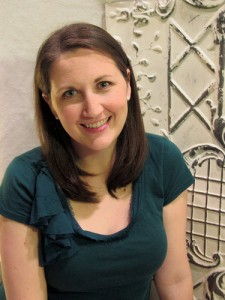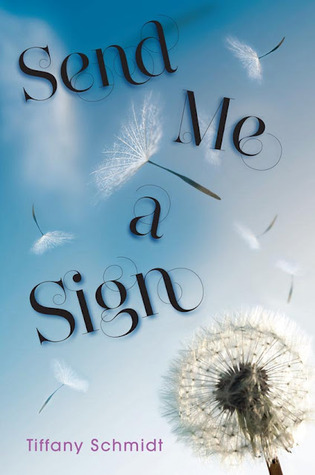 Tiffany Schmidt is the author of “Send Me A Sign.” The following is a complete transcript of her interview with Cracking the Cover.
Tiffany Schmidt is the author of “Send Me A Sign.” The following is a complete transcript of her interview with Cracking the Cover.
Have you always wanted to be a writer?
I’ve always written, but for a long time I’d retired the idea of being an author. I’d shelved it away with astronaut, Rainbow Brite, Sea World Trainer, Disney Princess, and all those other dream jobs of my childhood. Authors, in my mind, had more cool points than rock stars and movie stars combined—the idea that I could ever join the ranks on the bookstore shelves seemed unattainable.
I can’t remember a specific moment when I decided my desire to be an author outweighed by fear of the rejection, but I can remember how thrilled and terrified I felt the first time I sent queries letters out into the world of literary agents.
It was one of the best decisions I ever made.
Why write for young people?
I don’t know that I write for young people – I just write about them. I’ve always been fascinated with the pace and dynamics of teen years. Before I had my twins I was teacher, and it was amazing to see how much my students changed from September to June. Some students would reinvent themselves several times during the course of those nine months, friendships would evolve, relationships would start—become all-consuming—end. It’s such an age of flux and discovery—and such a memorable and important time in life. I love playing with all that in novels.
Where do your ideas come from?
Oh, my mother has been trying to figure this out since I was three years old and told her long, complicated stories about how “it wasn’t me” who shook the can of grape soda and sprayed it all over the kitchen walls.
I honestly have no idea where my ideas come from—usually some aspect of life that I just can’t stop thinking about.
Where did the idea for “Send Me A Sign” come from?
Probably from the same muse who told me to shake the grape soda. Or who encouraged me to give myself and all my Barbies a haircut.
Also, the song “Break Myself” by Something Corporate was a major inspiration for the novel.
Because of the subject matter, “Send Me A Sign” is at times hard to read. Was it hard to write?
There were many moments while I was researching and writing Send Me A Sign where I wanted to give up. The idea of doing justice to such a scary disease—both getting the medical aspects right and also the emotional toll that it takes on everyone in the novel—was so daunting.
It was so important to me that my portrayal of Mia’s experience be respectful of cancer patients, but also acknowledge that there isn’t one right or wrong way to have cancer.
Do you have any personal experience with cancer?
Unfortunately I feel like there are very few, very lucky people who have no personal experience with cancer. I hope that someday this isn’t true – that soon we can all look back on cancer the way we do polio or some other disease that’s been rendered preventable by modern medicine.
That being said, Send Me A Sign is dedicated to a former student of mine who passed away from cancer.
 Mia decides to shut out all her friends. That can be seen as either a very brave or very selfish move. How did that story arc come about?
Mia decides to shut out all her friends. That can be seen as either a very brave or very selfish move. How did that story arc come about?
Mia’s decision not to share her illness with her friends is both brave AND cowardly—she wants to protect them, but she’s also protecting herself and preventing herself from having to face the realities of her illness.
It’s been fascinating to me that, since writing the book, I’ve heard of more and more real life cancer patients who made the same decision Mia did. Many of their rationales matched my motivation for writing Send Me A Sign the way I did – this fear that cancer would become their identity and people wouldn’t be able to see beyond the disease.
In a time when the fantastical, fairy tale and otherworldly is so popular, why do you write contemporary fiction?
I love contemporary fiction. So many of my favorite novels – Anna and the French Kiss, Some Girls Are, Dairy Queen, The Truth About Forever, Twenty Boy Summer… – fall within this genre. I think there’s something so captivating about playing with ideas that are real and could potentially occur.
This isn’t to say my bookshelves aren’t also filled with the fantastical, fairy tale, and otherworldly… or that I’d never dabble in writing one of those.
Why do you think “Send Me A Sign” does/will appeal to young readers.
I think we all experience times when our lives seem to be out of our control—or times when we wish there were clear signs about what choice to make when faced with a difficult decision. I hope that Mia’s superstitions and struggle to feel like she’s in charge of her own life will appeal to readers of all ages.
How has your writing evolved to get you to this point?
I was just telling one of my critique partners that now when I write, I hear her voice in my head. This is true, but I think it’s more representative of the biggest way my writing has evolved—I’m able to be more critical of my work as I write. I don’t have to finish a whole draft before I stop to revise, and if something feels *forced* or *wrong,* I’ll pause to reconsider my plot and try a new direction – even if it wasn’t where I planned to go with the story.
What are you working on now?
I’m working on edits for Bright Before Sunrise. This is another YA contemporary and it will be published by Walker in winter, 2014. Bright Before Sunrise is a story told in one-night; it’s also dual-perspective, with both a female and male narrator.
The male voice and the short timeframe within the novel have been fun challenges while both writing and revising. I can’t wait to share it with you! (T-minus 18ish months!)
Is there a book from your youth that still resonates with you today?
I was/ am fascinated by As The Waltz Was Ending by Emma MacAlik Butterworth. I’m pretty sure it’s out of print, but I’ve got several copies on my bookshelf. It was based on the author’s experiences of being a ballerina with the Vienna State Opera during World War Two. The story of Emma dancing in the middle of a city that’s tumbling down is both beautiful and horrifying. It’s told with heart-aching honesty that I haven’t forgotten in the twenty years since I first read it.
